Next Steps
Moving into prototyping, our biggest focus will be figuring out how to develop and maintain a level of trust between strangers who live in the same building or area. Without this, users may be reluctant to share to begin with. By exploring different design alternatives, we hope to find a method of communicating trust that is effective and safe, meaning concerns about consuming food produced by neighbors will be alleviated as much as possible. We also wish to create a prototype with building a rapport between users in mind.
We aim to accommodate needs unique to both providers and receivers (respecting that some users may fill either role in our design). A buyer should feel safe acquiring and consuming food, efficiently find food that fits their needs, and provide feedback to a seller that other potential buyers can utilize. A seller should be able to advertise their food accurately and efficiently, and feel the same sense of satisfaction that comes with sharing practices as they exist now.
Additional recommendations might be to consider the timing of food availability and the ability to support sharing ingredients (possibly regarding this as a special, simple version of the process for sharing meals).
Revised Task Examples
1. Tony – the time-constrained student.
Tony is a UBC student who lives in dorms on campus with his girlfriend. He is currently taking 5 courses and is swamped with homework and weekly assignments. This leaves him with minimal time to buy groceries and prepare food for him and his girlfriend. Tony doesn’t want to keep ordering food delivery from restaurants as the delivery fees and bills are stacking up, and the restaurant foods are too salty and greasy for his liking. However, food delivery is the most convenient and time saving compared with his other options of buying groceries and cooking or eating out at restaurants.
2. Adam – the cook for numerous people.
Adam recently moved from Port Moody to Vancouver to be closer to his new workplace. One of Adam’s hobbies is cooking as it allows him to try food from various cuisines. Living with his family allowed him to cook multiple dishes at a time since he would always have people to share his food with him. This is now an issue for Adam since he lives alone, he finds it hard to adjust his cooking style to cook just one portion. He is constantly finding himself with too many leftovers and feels that the leftovers are preventing him from cooking and trying new dishes. Unfortunately, since Adam is new to his neighborhood, he hasn’t found anyone to share his food with yet.
3. John & Mary – the generous neighbour.
John and Mary have been living in the neighbourhood for over 20 years with their 3 children. They own a 5 bedroom house and they are also renting out their basement suite. Currently, Mary prepares meals for her family as well as the tenant. To do this, she has to go grocery shopping twice a week. Additionally, as the couple are very close with their neighbours, they often will babysit each other’s children as well as share food with each other. During holidays, their tradition is to bake cookies and other appetizers to share with extended family and neighbours.
Prioritized List of Requirements
Absolutely must include:
The requirements in this category mainly include basic abilities for users to interact with listed items. From our field study, we found that not everyone is comfortable and trusting of their neighbors, so we strongly believe that creating a system to build trust between one another will be crucial in supporting the application.
- Users must have the ability to:
- Browse accurate depictions of food and see food items that are available
- Post food for sale or give away for free
- Purchase (claim if free) food for a clear cost in relation to the proportion and quality of food they are getting
- A system that can help build trust between users so that they feel safe using the application and interacting with one another
- At the moment, we have a couple of ideas on how we can increase trust (for example, writing reviews for the food vs writing reviews for the user who posted) which will need to be explored further.
- A level of trust should communicate with users that a seller is legitimate in what they sell, and that they do not need to have any health concerns consuming their food
Should include:
This category includes features that helps to create trust between users and the system. To build trust, we want users to be able to learn more about each other, so they don’t feel like they are strangers. Additionally, we found that knowing the process of how a food is prepared is valuable to know as well.
- A system to facilitate messaging between users
- Allow users to communicate the allergens in the household of the receiver
- Ability for users to edit their own profiles and view the profiles of other users
- The ability for users to communicate the process of how food is prepared when listing an item up for sale
Could include:
The features in this category are non-critical and provide users with an easier way to search for food and learn more about a dish.
- Tags so that users can filter through all the available options
- Ability for users to post a complete ingredient list in food
- Ability to put up ingredients that have not been cooked yet
Could exclude:
We believe that this feature would be nice to have for those who have established themselves within a neighbourhood and regularly interact within one, but we want to maintain a focus on building food sharing rapport where it does not exist and leveraging computing to make it more efficient where it does. Swapping is relevant to the latter case, but it is not critical we explicitly afford swapping.
- Ability for users to swap/trade foods explicitly
Design Alternatives
Alternative #1: Card System (UberEats-esque)
With this design, users are able to scroll through previews of dishes that are available near them. On each preview, it could display a picture taken of the dish, name, price, and a rating that shows how popular the dish or seller has been recently. Clicking on the preview would bring up more details of the dish, such as ingredients (with allergens being highlighted), a high-level description of how it was prepared, special notes by the seller, a way to contact the seller, and a way to indicate your interest in the meal. Users can also choose to view a seller before looking at the food they are selling to see a short bio and reviews given to them. After arranging to order a dish, the buyer will have the option to leave positive feedback tags about the food or the seller, but also the option to report something that went wrong.
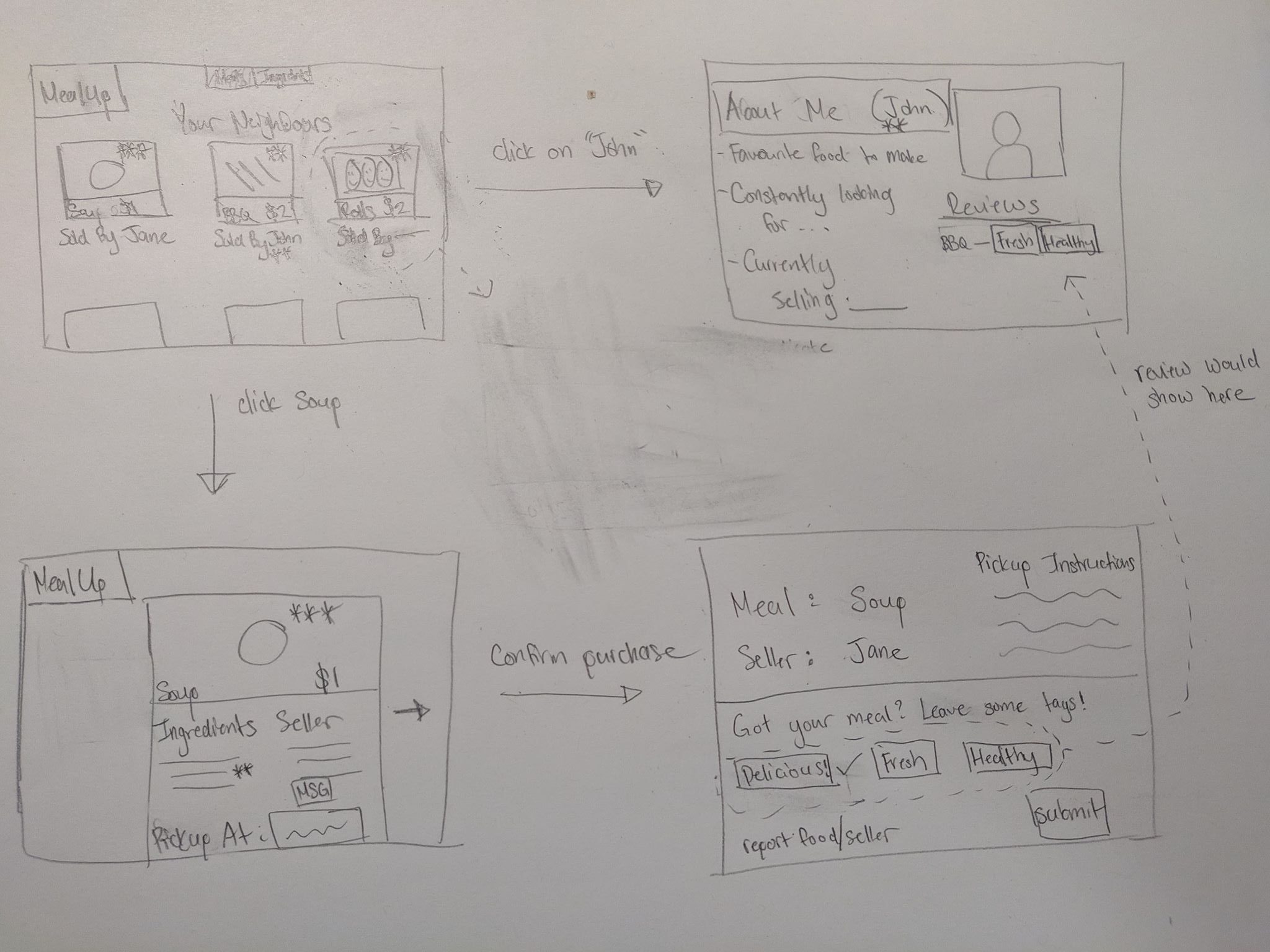
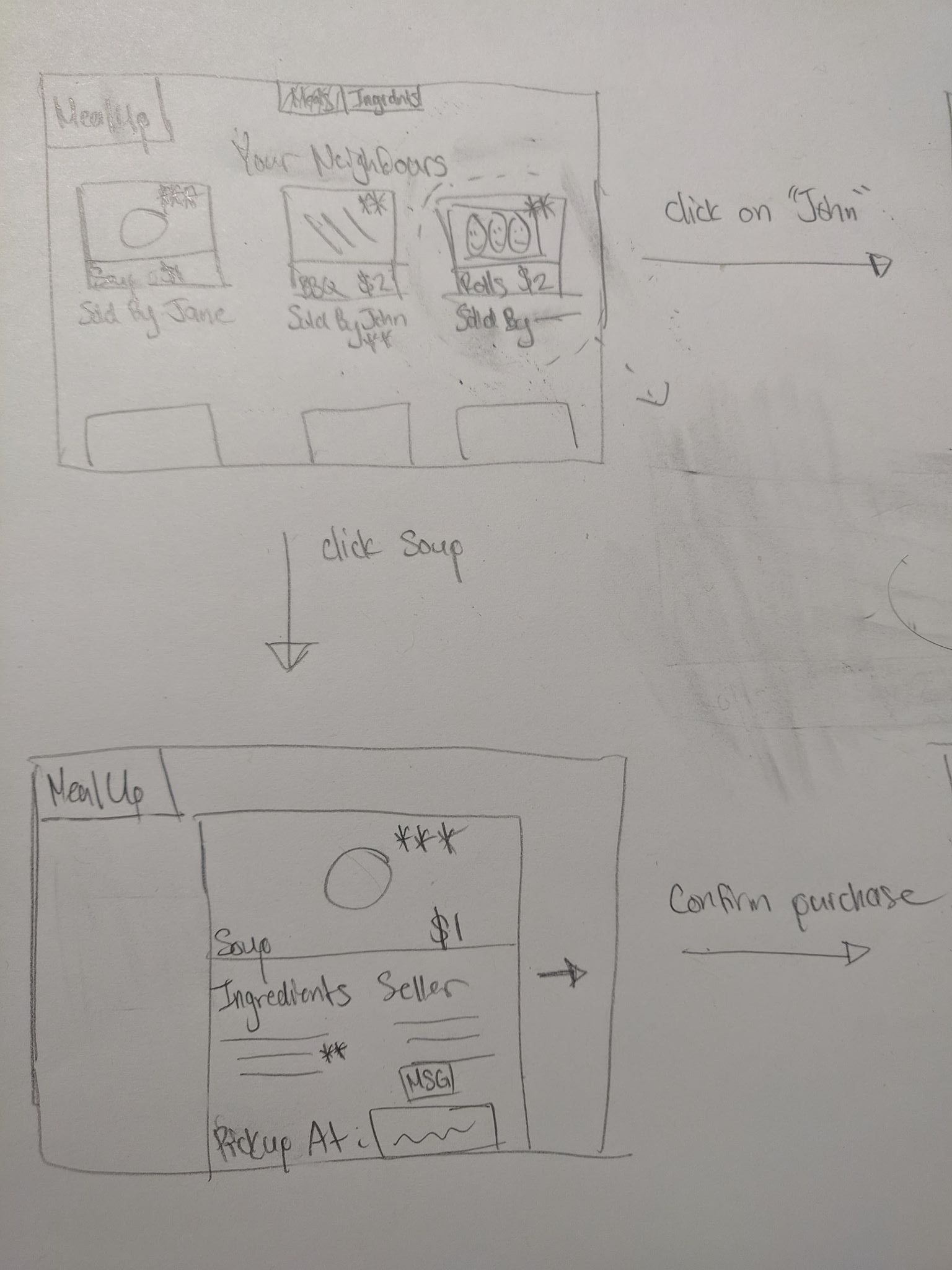
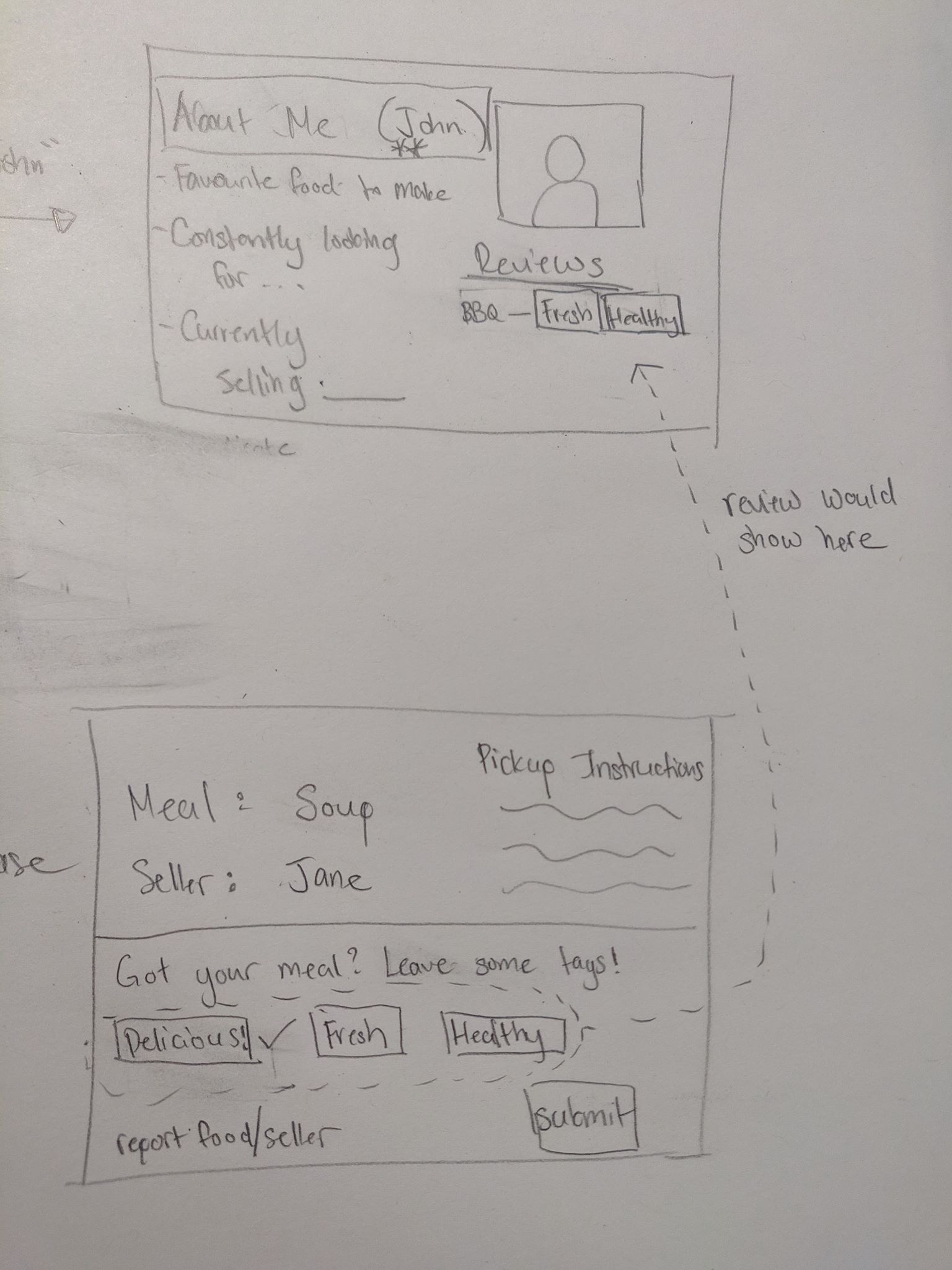
Pros:
- Easy to show list of available dishes in their area with relevant details
- Personalizable bio on the profiles allows sellers to express themselves but also indicate what food they like to prepare
- Positive feedback tags are simple to use to encourage buyers to leave feedback for other buyers
Cons:
- Reviews are limited by predetermined tags and can’t leave personal comments
- A lot of initial trust is based on first impression and ability for the seller to disclose information about their dish or their profile (e.g limited by language or communication skills)
- If a user wanted to see if there was a type of food available, they are limited by their ability to scroll through the cards
Alternative #2: Review System (Yelp-esque)
For alternative 3, we plan to have a web application where users can search for food similar to how Yelp searches for restaurants. There would be a search bar and the user can filter by different preferences, like price, culture, etc.
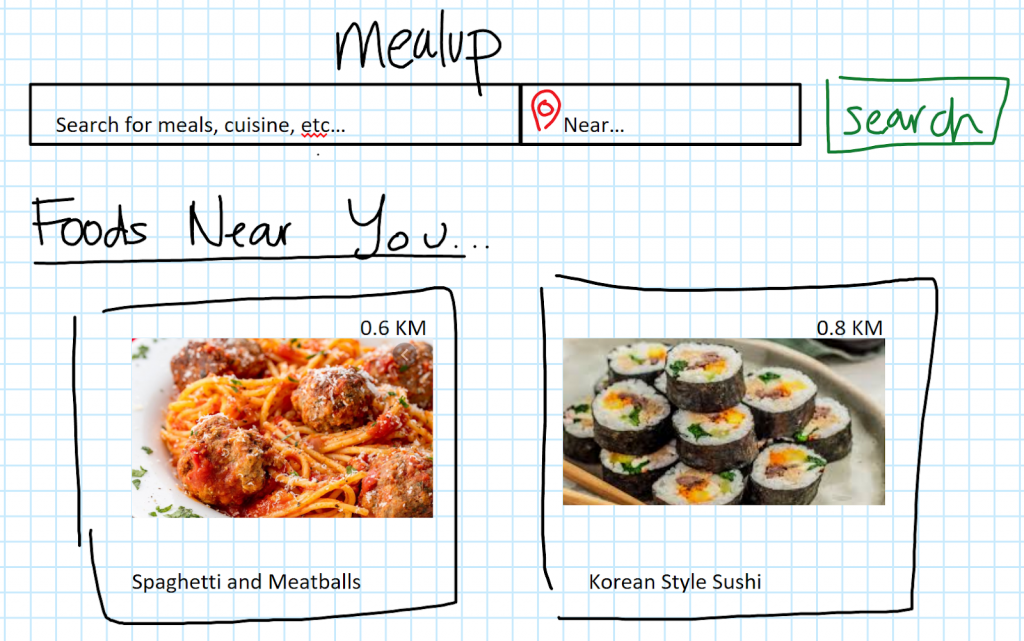
Additionally, once the user selects a food that they want to purchase, they will be able to see the reviews that the seller has. Previous buyers are able to rate the food out of 5 stars with 5 being the best, upload images of the food that they received, and write comments as well. 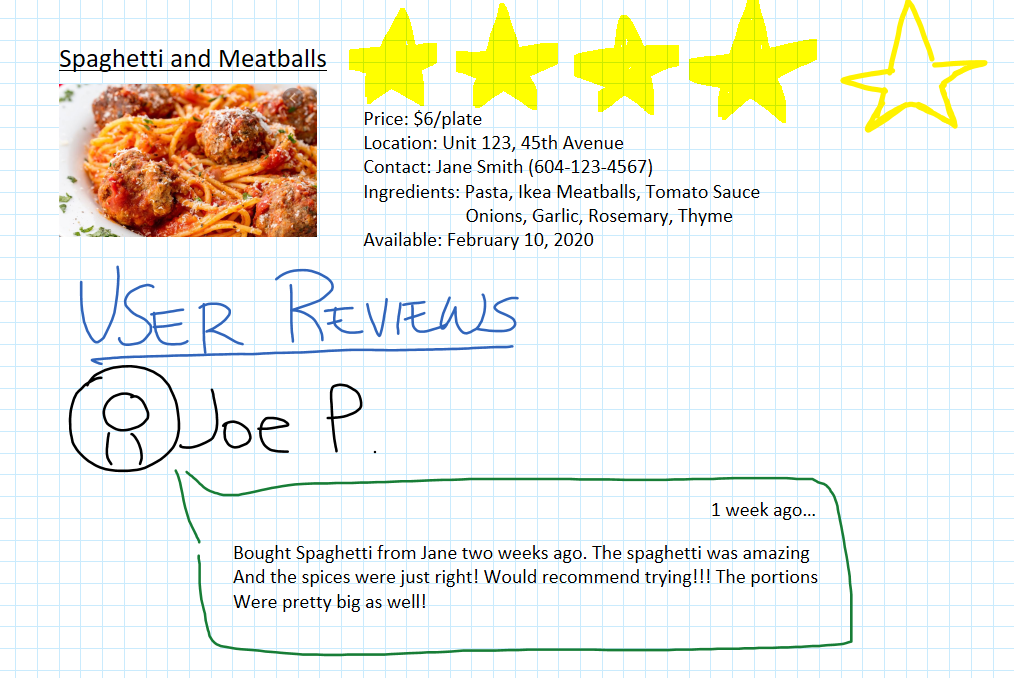
Pros:
- New users will be able to easily see previous reviews and comments of sellers and if the reviews are good, they may develop a sense of trust with the seller for the food that they are buying.
Cons:
- Since this system would be used ideally for neighbours or people living in a close area, it may be hard for users to leave truthful or bad reviews, which may skew the system.
- There may be limited sellers in the area, and the review system may not be as beneficial in the long run, especially since the buyer may have developed a stronger relationship or sense of trust with the seller over time
Alternative #3: Casual Messaging Platform (Instagram-esque)
For our fourth design alternative, we plan on having a casual messaging platform where sellers can take pictures of the food that they are selling, write descriptions, add hashtags, upload videos or live stream their food preparation, as well as create posts that will show up on the newsfeed of the platform. Buyers can then sort the newsfeed based on hashtags, distance, price, or by who they follow and scroll through to see what food is available to purchase. The buyer can also tune in on a live stream or look at videos of how the food was made to be able to see what the food preparation process is like. When the buyer is interested, they can send direct messages to the seller to arrange for time of pickup or ask any questions that they have.
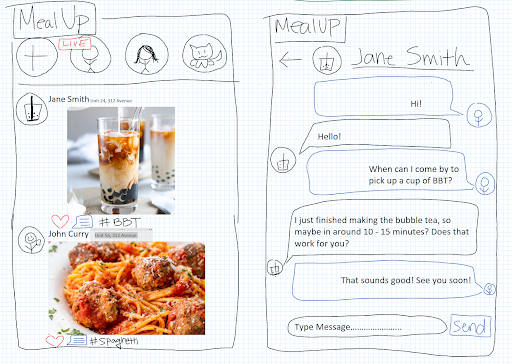
Pros:
- By giving the option for the seller to post their food preparation process, they can help to establish a sense of trust in the food that they make for their customers/neighbours
- Buyers would be able to see the videos of the food preparation and judge for themselves if the preparation meets their standards
- With the direct messages system, it would help encourage interaction between the buyer and seller, which is ideal in this case because they would ideally be neighbours and can get to know each other.
Cons:
- Sellers may see video taping or live streaming their cooking process as a hassle and only post descriptions or images of the food that they are selling
- Buyers may find the layout too big and may have to scroll for longer to find something that they desire